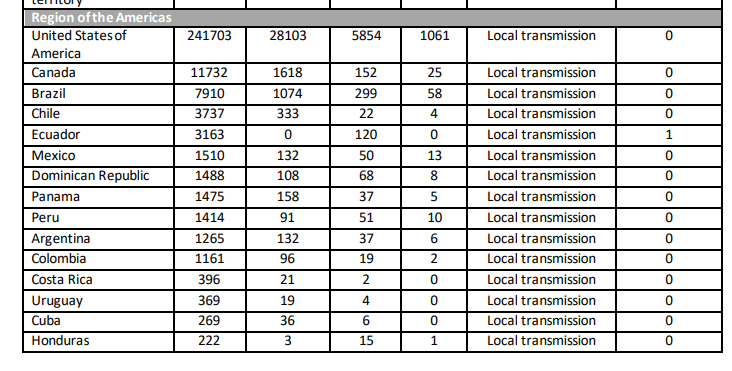Saturday April 4, 2020 ~ GLOBAL
by Mary Brooke, B.Sc. ~ West Shore Voice News
Now at April 4, 2020 there are 1,051,635 confirmed cases of COVID-19 worldwide, says the World Health Organization (WHO) in their COVID-19 Situation Report #75.
Of those, 279,543 are in the Americas (a WHO category that includes USA, Canada, Mexico and South America).
The death count is 56,985 worldwide. Of those deaths, 6,802 occurred in the Americas (with 1,202 of those deaths since yesterday, so it’s ramping up — mostly in the USA right now).
The United States has seen 5,854 deaths so far, with Canada at a count of 152.

In Europe, Italy is still suffering under a very high count of cases at 119,827 with 14,681 deaths. Spain is in that same range of impact, with 117,710 cases and 10,935 deaths.
Notably, where strict measures were in place early, Israel reports 7,030 cases but only 36 deaths, similarly for Norway with 5,208 cases and just 44 deaths.
The spread of COVID-19 was seen in early January in China. Containment of the population in affected areas of China gave the rest of the world time to prepare for the inevitable community spread in a world where international travel seems the norm.
WHO waited until March 11 to officially declare a global pandemic for the novel coronavirus, and at one point along the way gave it an official name ‘COVID-19’ which rapidly caught on around the world, along with the infection rate in many countries.

As more information about the appearance and performance of COVID-19 becomes available each day from around the world, some trends on the severity of population impact are observed.
Death counts due to COVID-19 tend to vary around the world based on the percentage of the population that is over age 60 (older persons are being seen to be more susceptible to the harsher aspects of the respiratory disease), the level of air pollution in a region (e.g. northern Italy had a lot of industrial pollution), and how soon the measures of self-isolation and social distancing are brought into effect as well as how well they are enforced.
Underpinning that latter point about achieving societal compliance for essentially what becomes a voluntary lockdown is a study on how populations relate to and assess the leadership in their region or country. The more that leaders are known and trusted, the better the rate of compliance with measures such as self-isolation and physical distancing.

Though overall, the degree of preparedness of the health care system — including inventory of supplies such as protective equipment — seems to be the next-phase arbiter of success in the fight against COVID-19 when more people need hospitalization. The whole idea of ‘flattening the curve’ is to try and control the intensity of impact on the hospital system (i.e. fewer patients at one time allows for better management of supplies and availability of skilled personnel).
======= RELATED:
EDITORIAL: Adjusting to COVID-19 is no easy feat and commands humility ~ by Mary Brooke (March 30, 2020)



